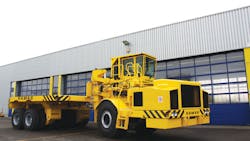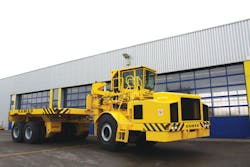Gentle Giant Transports Molten Steel
Transporting molten steel can be extremely dangerous because any sudden movement can cause an accident with serious consequences. So, whenever a ladle of molten steel must be transported within a steel plant, it must be done slowly and by a vehicle with precise drive, steering, braking, and level control. The longer the travel distance, and the slower the vehicle speed, the more money it costs to transfer a ladle. So if a vehicle can transport a ladle faster without sacrificing safety, it would improve a steel plant’s productivity.
Because they move so slowly, most ladle carriers are used only for short distances. Not so with Kamag’s 3503 ladle carrier. Manufactured by Kamag Transporttechnik, Ulm, Germany, the 3503 has a payload of 180 tons and is nearly 16 meters long. A ladle is placed in the transporter’s payload platform, which can be hydraulically lowered onto the ground for crane loading. An extensive range of protective measures ensures that the driver’s cabin and the drive components are protected from the heat.
This file type includes high resolution graphics and schematics when applicable.
The transporter can be maneuvered from the driver’s cab clearly and easily despite the vehicle’s large size. Hydraulic axle compensation corrects irregularities from uneven ground surfaces. Furthermore, articulated steering allows the operator to maneuver around obstacles throughout the plant. The hydrostatic drive can scale gradients up to 8% when fully loaded and reaches a speed of up to 6 km/h with the dangerous cargo. The high maneuverability and relatively high speed of the transporter cuts transportation time, thereby increasing productivity over conventional machines.



